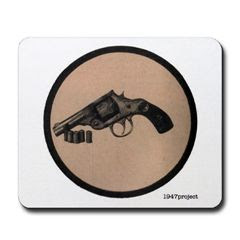April 18, 1947
Los Angeles
Arriving at his home at 7143 Hollywood Blvd. tonight, James Utley, 43, tangled with Herbert Robertson, 45, who was lurking in the yard. Hearing gunfire, Utley’s wife and daughter called police. Utley’s is a name well known among crime crusaders, so Detective G.L. Smith went to the scene with patrol officers.
Utley refused to sign a complaint against Robertson, who he admitted had recently written him a letter demanding $500. Nevertheless, police arrested Robertson on suspicion of robbery. Robertson told officers that he was also a resident of 7143 Hollywood Blvd., although the address on his social security card read 1907 W. Sixth Street.
Utley claimed Robertson had pulled a revolver, which Utley deflected, causing the shot to go wild. Robertson countered that Utley had fired the shot. The gun was found in a car parked in the yard.
James Utley is best remembered for a shocking incident on August, 16, 1946, when two men followed him into popular Hollywood watering hole Lucey’s Restaurant (5444 Melrose Ave.) during the lunch rush. While one man held the other diners –among them Joel McCrea, Eddie Cantor, Stephen Crane and Joan Davis-at gunpoint, the other administered a thorough blackjacking to Utley. This was assumed by many diners to be a movie stunt. The assailants then fled through the crowd of autograph hunters outside the restaurant.
Utley, former operator of the bingo concession on Tony Cornero’s Lux gambling ship (and then under indictment for these activities), former investigator for politically ambitious Clifton’s Cafeteria owner Clifford E. Clinton, acquitted in 1939 on charges of extortion and bribery, convicted two years later of violating Federal Narcotics laws and sentenced to two years in prison, refused to identify his attackers, suggest any reason for the attack or in fact to make any statement at all.

